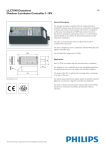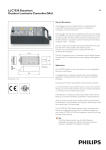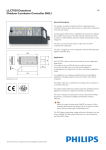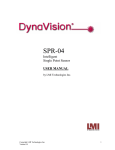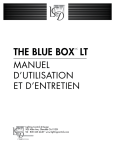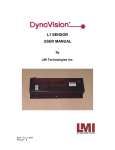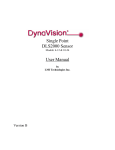Download LLC7020 Outdoor Luminaire Controller
Transcript
LLC7020 Outdoor Luminaire Controller 1/6 General Description The Outdoor Luminaire Controller (OLC) is a high-performance LonWorks® network device that connects to, monitors, controls and drives a lamp-ballast combination. Communication with the OLC is established via the power line utilizing the LonTalk® open protocol. It interacts with the ballast by switching its output and by means of a 1-10V dimming interface. Beside this it monitors the electrical characteristics of the lamp-ballast combination. The OLC can autonomously switch its output ON and OFF if combined with a photocell. The OLC is designed to work in combination with the Philips Segment Controller (SC) in a Philips Starsense outdoor lighting telemanagement system. The Philips Starsense system product range consists of: LLC7020 Outdoor Luminaire Controller LFC7065 Segment Controller Applications 63 141,5 63 Benefits and advantages M6 156 Dimensions in mm Each OLC can monitor and drive one ballast-lamp combination. It is designed for use in residential, street and road lighting applications, including parking lots, ports, train stations and industrial complexes. The design of the OLC is optimized for mounting within a luminaire. It is recommended for optimal performance not to connect more the 100 OLC’s to one SC. The Philips OLC is released and authorised to solely interact with the Philips SC, consult the local Philips representative if desired otherwise. The major benefits and advantages of using the Starsense telemanagement system are: • Energy savings through dimming and switching • Save costs on maintenance through reduced lamp scouting and improved predictive maintenance • Improve safety by detecting, reporting and reducing night black-outs • Reduce light pollution so that the light levels are in harmony with their surroundings and dim-up on-demand when required Tip The Philips Starsense system uses the Philips Starsense Configurator and Supervisor software. The license to use this software is embedded in the Segment Controller LLC7020 Outdoor Luminaire Controller 2/6 General operation Dimming The OLC combines three main functions. The controller function receives the incoming commands from the SC and acts accordingly. A driver switches the output relay and regulates the 1-10V dimming interface. The monitor function measures the current, mains voltage, mains frequency, power factor, burning hours and power consumption of the connected lamp-ballast combination. These measurements are used to determine the energy consumption. Based on these measurements, the monitor function determines if the connected lampballast is functioning within configured thresholds and sets its status that can be accessed by the SC. One OLC can switch, control and monitor one light point. A default configured OLC will switch ON its output at maximum level on power-up. The SC sends the dimming level, based on many configuration properties, to the OLC. A dimming correlation may look as follows: The OLC will transfer the incoming dimming command to the OLC’s driver, which drives the 1-10V dimming interface. The OLC is equipped with a power line transceiver, which can repeat messages. The SC monitors and controls the dynamic repeating functionality centrally. If communication fails between the SC and a specific OLC, another OLC can be designated dynamically by the SC, which can repeat messages. The SC will autonomously and continuously keep track of which OLC’s can be reached directly and which ones require message repeating. 10 Dimming interface voltage Repeating (V) 8 6 4 2 0 0 (%) 10 20 30 40 50 60 70 80 90 100 Lamp output Dimming correlation Tip Check the Philips Dynavision ballast/controller datasheet for the relationship between the interface signal level and the light output, Mounting information Released ballast The OLC is designed to be installed inside a luminaire, another adjacent OLC can be mounted in poles, gear-trays, and separate boxes. If the OLC is mounted inside a pole it may only be mounted upright, as shown in the mounting picture. The OLC may be mounted in any position if the enclosure is IP43 or above. IP > 20 Mounting Currently the ballast released to interact with the 1-10V dimming outputs of the OLC are: • Philips HID-DV 1-10V 150 SON • Philips HID-DV 1-10V 100 SON • Philips HID-DV 1-10V 70 SON • Philips HID-DV 1-10V 150 CDO • Philips HID-DV 1-10V 100 CDO • Philips HID-DV 1-10V 70 CDO • Philips HID-DVC 1-10V 250 SON • Philips HID-DVC 1-10V 400 SON Any other component must be validated before it may be used with the OLC. Contact your local Philips representative about how to obtain component validation. LLC7020 Outdoor Luminaire Controller 3/6 Neuron® ID 0,75 - 4 mm2 Each OLC has a unique 48-bit identifier called Neuron® ID. A user cannot rewrite this identifier. The Neuron® ID is printed on the three barcode labels placed on the front of the OLC, which barcode readers can read. 8 mm optional photocell 1-10V 1-10V LN NL LS + - - + L N PE L N L LLC 7020 L N PE 230V 50Hz Datasheet LLC7020 /00 Typical connection User Manual OLC label ! Attention When the OLC is installed it is vital for the Starsense system operation that it knows the Neuron® ID and the location of the device. A drawing or list indicating which Neuron® ID belongs to which installed OLC acts as an input for creating the Starsense telemanagement configuration off-line. Tip See Starsense user manual for usage suggestions. Status messages The OLC continuously monitors the current, mains voltage, power factor, and energy consumption. These measured values are compared locally against threshold values. The OLC will set its internal status accordingly as soon as a threshold level j to k, l to m and n and delay time are exceeded. Threshold levels are pre-configured within the Starsense Configurator software and downloaded into the OLC, see ‘Current threshold example’ graph. Each newly generated status message is time-stamped. Only the last two status messages are stored in memory. Energy consumption and burning hours are stored in non-volatile OLC memory and can be obtained, together with status messages, by the SC and Starsense Supervisor software. (%) Powering the OLC ON 4 90 Current too high 80 70 Current value Apply mains power to the OLC once it is mounted securely and all its wiring is connected as shown in the typical connection diagram. After power-up, both red LEDs will come ON for 2 seconds. The unit is fully operational and ready for commissioning and configuration after both red LEDs go OFF. The green power LED should stay ON continuously indicating that power is applied. The OLC is now in its default configuration. The safe-guard mechanisms, burning hours counter, power-up behavior and manual interfaces are operational. 100 60 3 Current normal 50 40 2 30 20 1 Current too low 10 0 5 No current 0 20 (%) 40 60 80 100 Dim value Level 1 Level 2 Level 3 Current threshold example LLC7020 Outdoor Luminaire Controller 4/6 Safe-guard mechanism with photocell User Interface The OLC can (configuration property) fall back onto photocell operation when it detects a communication failure with the SC. This safe-guard mechanism prevents light points from staying OFF during the night, causing dangerous situations, and from staying ON during the day, which would waste energy. The OLC is equipped with one single-pole 230VAC input to monitor the photocell operation. When in safe-guard mode, the OLC will follow the photocell input with its output. A factory default OLC will switch to the safe-guard state if a 230VAC voltage level is detected on the photocell input. The following indication LEDs and buttons perform important functions and provide status information regarding the OLC. Note: It is only possible to connect photocells which use an electromagnetic relay for load switching. Safe-guard mechanism with back-up scheduler When no photocell is being used the back-up scheduler can be used. The OLC can (configuration property) fall back to run according to an pre-configured schedule when it detects a communication failure with the SC. The OLC will use this back-up schedule to switch its output. It runs on its own internal real-time clock if it is in this stand-alone mode. The switch ON level can be pre-configured through the OLC power-up value. Daylight control based on photocell operation When in daylight control mode (configuration property), the OLC will follow the photocell input with its output while still receiving and executing the dimming levels. In this way the switching points are controlled by the available sunlight and the light level is controlled by the Starsense system. Lamp-ballast monitoring is enabled within daylight control. The following functional table is foreseen for photocell use. Photocell detection Dusk Dawn Photocell relay Closed Open Photocell Line out Mains voltage Nothing Power The green LED is ON when the OLC unit has mains power. Service The OLC yellow service pin is a recessed push button used to transmit the Neuron® ID. The yellow service LED indicates the internal OLC state. LED is ON: Application-less. The OLC has only communication parameters loaded. LED is blinking: Unconfigured. This OLC state indicates that it has communication parameters and an application program and network address information. This OLC state is the “idle” state. Commissioning and configuration need to be performed. LED is OFF: Configured. The OLC factory default is in this state. The OLC has communication parameters, application program and address information. The OLC is operating normally. Local output timer • Pressing the local output timer button while the output is OFF will switch the output ON for 15 minutes at maximum. The output will be turned OFF after the timer has expired. During this period the red local output timer LED blinks slowly. • Pressing the local output timer button while the output is at maximum level will cause the output to switch for 15 minutes at minimum level. The output will be turned OFF after the timer has expired. During this period the red local output timer LED blinks rapidly. • Pressing the local output timer button while the output is ON at a dimmed level will switch the output OFF. Attention The OLCs output will be switched OFF after the local output timer expires. To switch the output structurally ON, reboot the OLC to have the output automatically switched to its configured power-up level. Maintenance Pressing the red maintenance button causes the red maintenance LED to light up, indicating that the internal status message “Maintenance button pressed” has been set, which is reset automatically after 24 hours. This can be used to indicate within the system that maintenance has been performed on a specific pole. ! Note: The OLC output will be switched (if the output is OFF it will switch ON, if the output was ON it will switch OFF) disregarding configurations for 15min after the OLC receives a “wink” command. Also the red maintenance and local output timer LEDs will flash. LLC7020 Outdoor Luminaire Controller 5/6 Technical data Storage conditions Temperature Relative humidity -25°C to +85°C 10% to 95%; condensation allowed Operating conditions Ambient temperature Case temperature Relative humidity -20°C to +75°C +85°C (on Tcase spot, see OLC cover) 20% to 95%; condensation allowed Mains connection Rated voltage Frequency Maximum load Mains connector screw terminal Wire range Wire strip length Flathead screwdriver tip Screw tightening torque With tolerance for performance: 180VAC to 253VAC With tolerance for operation: 180VAC to 380VAC 50Hz ±5% 400W, any type of lamp load MKDS 3/ 2 0.2 to 4mm2 solid 0.2 to 2.5mm2 stranded Recommendation 0.75 to 4mm2 solid 8mm 3mm 0.5Nm Power consumption Stand-by Relay OFF Stand-by Relay ON Communicating 2.5W 3W ≤ 8 W (peak, communicating with max 1Ap-p into low impedance loads) Power line interface Channel type Coupling Protocol Power line transceivers Approval PL-20C power line L-N via mains ANSI/EIA 709.1-A-1999 Compliant to ANSI/EIA 709.2 Cenelec 50065 compliant, C-band: 125-140kHz Automated B-band selection if communication on C-band fails Complies with FCC, Industry Canada, Japan MPT, and European CENELEC EN50065-1 power line communication regulations CEN 14908-3:2006 Dim interface Dim control Resolution Dim control connector 1–10V polarity sensitive < 0.5% Screw terminals GMKDS 3/2, rated at 230VAC Wire range Wire strip length Flathead screwdriver tip Screw tightening torque Interface compatible with 0.2 to 4mm2 solid 0.2 to 2.5mm2 stranded Recommendation 0.75 to 4mm2 solid 8mm 3mm 0.5Nm IEC 60929:2004 Photocell input Input Input connector Wire range Wire strip length Flathead screwdriver tip Screw tightening torque 230VAC Screw terminals GMKDS 3/2, rated at 230VAC 0.2 to 4mm2 solid 0.2 to 2.5mm2 stranded Recommendation 0.75 to 4mm2 solid 8mm 3mm 0.5Nm Accuracy Voltage Current Energy < 3% < 3% < 3% Indicators Power LED (green) Indicating power ON/OFF Service LED (yellow) Indicating the state of the OLC Local output timer LED (red) Indicating the internal manual state Maintenance LED (red) Indicating the maintenance status Manual controls Yellow service button: Send Neuron® ID Blue local output timer button: Manual output control Red maintenance button: Set maintenance status Barcode code Code128 Back-up scheduler accuracy Safety pre-fuse requirement Real-time clock accuracy 0.02% Max. value pre-fuse: 6 ATH 0.05% Norms Protection class Flammability Glow wire test Safety Immunity Emission IP20 in any position IP22 in upright position UL94 V.0 300°C/1.2Kg, 16cm3/10min DIN53735 EN61347-2-11 EN61547; EN50065-2-1 CISPR22 class B Dimensions Weight H: 15.6 cm, W: 6.3 cm, D: 6.3 cm 0.31 kg LLC7020 Outdoor Luminaire Controller 6/6 LonWorks and Neuron are trademarks of the Echelon Corporation registered in the United States and other countries. Packing data Type Inner Box Outer Box Ordering Data Type LLC7020/00 322 636 36042 05/2008 Data subject to change www.philips.com/lightingcontrols Box dimensions (mm) 166 x 68 x 68 345 x 214 x 174 MOQ 1 Qty Material 1 12 card board card board Ordering number 9137 003 25403 EAN code level 1 8711559 730868 Weight (Kg) net 0.31 3.7 EAN code level 3 8711559 730875 gross 0.34 4.32 EOC 730868 99






